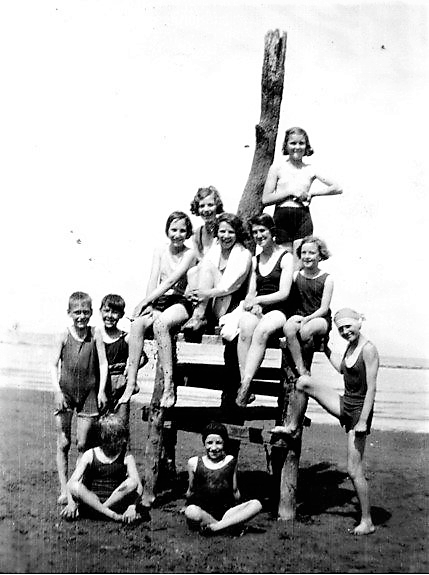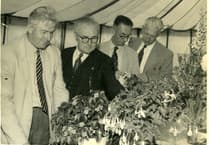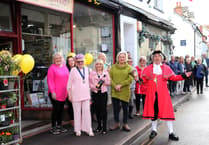Once it was a thriving holiday venue bringing generations of families to its beach and cliffs. But since 2019, Watchet’s Helwell Bay holiday chalets site has become disused and overgrown - the victim of arson and vandalism - and the rows of brightly painted beach homes have gone.
Yet 90 years ago, Helwell Bay Holiday Chalets was a thriving holiday destination, the brainchild of a Watchet businessman who had the idea for economy-priced family holidays 25 years before Billy Butlin.
Here, artist gallery-owner and local historian NICK COTTON looks back of the eventful life of Bromley Penny and the holiday legacy he left behind.
HELWELL Bay Holiday Camp is perched on the edge of the cliffs between Watchet and Doniford and until as recently as 2019, holidaymakers were still making their annual visit to this unique part of West Somerset, some of whom had been visiting for decades.
But the long tradition came to an end when the site was bought by a developer who had plans which up to now have failed to materialise. There were further setbacks when the remaining buildings were destroyed by fire in December last year.
It’s a far cry from the sunlit days of the early 1930s when irrepressible Bromley Penny, entrepreneur and fanatical cricket fan, first dreamed up the idea of encouraging holiday-makers to come to Helwell Bay, between Watchet and Doniford.
Inevitably he threw himself into the project with a youthful exuberance that put much younger people to shame, despite being ‘late Victorian’, as he described himself to me one day.

I remember his undisguised excitement when one of his heroes, Brian Johnson of Test Match Special fame, came to Watchet to record ‘Down Your Way’, a radio programme which interviewed local residents and played their choice of records.
The interview, as I remember it, took place in his office in Swain Street where he spoke of great former Watchet cricketers he had known, in particular the famous Harold Gimlett of Somerset and England, whose rise to cricketing fame was a real ‘Boys Own’ story but ended tragically in suicide.
Bromley was indeed Victorian, born in 1897, the year of the Queen’s Jubilee and as a young man saw action during the First World War when he was a dispatch rider. I remember him with some affection and like others, was easily seduced by his almost childlike enthusiasm and his habit of chiding people.
One “victim” was the long-suffering and good-natured Stella Blunt who was for many years his secretary, who took bookings for Helwell Bay and the Doniford bungalows, a separate part of the enterprise.
Bromley or ‘Brom’, as he was affectionately known, had anticipated the potential of a small holiday camp at Helwell Bay. It was certainly modest by comparison with Billy Butlin’s holiday camp in Minehead but pre-dated it by some 25 years.

+ 7
(View All)
The old diving platform at Helwell Bay in the 1930s. There were two platforms and it is still possible to see the remains. Standing is Peggy Milton. L-r Eileen Norman, Evelyn Bruford, Gwen Bulpin? Standing are Henry Binding and Dicky Hill? Sitting on the sand is Peggy Bruford
It certainly proved very popular and enthusiastic visitors arrived at the camp, made new friends and returned year after year. There is no question they enjoyed what at the time would be considered fairly basic amenities but the little park, the beach and the town of Watchet were more than adequate for their needs.
In the early years it was possible to access the beach from the site via a wooden flight of steps that has of course inevitably been claimed by the sea and not replaced.
In earlier years of Victorian sea bathing, the men and women were confined to separate beaches, Helwell designated for the men and West Street beach - on the other side of the harbour - for the women.
There were also two diving platforms and one is featured in a photograph of an array of smiling faces, not holidaymakers in this case but all identified as true Watchetonians.
Helwel Bay was no ordinary holiday camp, modest though it was. Cared for and administered by locals, its “extras” included an annual ‘Christmas blotter’ at the instigation no doubt of Brom and continued by the future owner, the engaging and eccentric Laurence Coldwell.
The featured blotter from 1972 is one of a number held in the Watchet Conservation Society archive. The lady with the engaging smile is Stella who we mentioned earlier.
Her daughter, Suzette Jones, has some wonderful memories of the ‘camp’. I hope she will forgive me as I am only including a little of the information she has imparted.
Significantly featured are ‘Cyril’s Busy Bees’ as they are titled, the Cyril being Mr Western who Suzette describes as the ‘handyman and gardener’ and his wife Edna who was in charge of the cleaners; they were the parents of Glenda Bale and the late Christine Somerfield.
The other busy bees are, Suzette believes, (from left to right): Margaret Meader, Doreen Broom, who lives in Minehead. The next, she suggests, might be Bet Williams, wife of the coalman, but she is unsure about the final lady. Can any reader give further information?
Suzette remembers the time when Bromley, finding he had an unexpectedly vacant chalet, offered it to Stella and her girls.
Suzette and her younger sister Julie were delighted by this unexpected treat. “There were lots of other children to play with and in the evening we would play rounders in front of the chalets”. She also remembers taking the steps to the beach and swimming to the diving platforms with the other children.
All that remains today are the remnants of the posts that supported the platforms. It is possible to see the evidence of their existence today as you walk across the beach towards Doniford.
The chalets remained with Bromley until 1975 when they were taken over by Laurence Coldwell. Later, Jean Howe owned the site and is still remembered with great affection and as a real stalwart of the town.So there we are, an age of innocence when delight was taken in such simple pleasures, a time before mobile phones, computers, and all the other modern gadgetry that now demand and steal our time.*My grateful thanks to Maurice Chidgey for use of the photo of the diving platform





Comments
This article has no comments yet. Be the first to leave a comment.